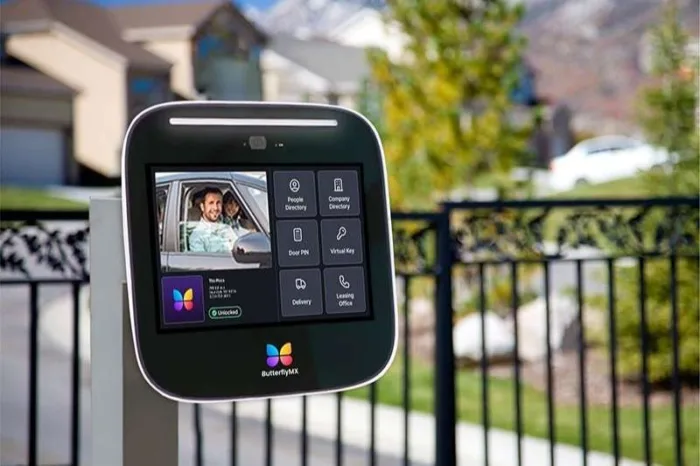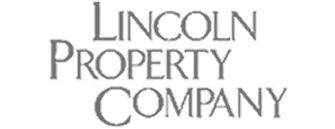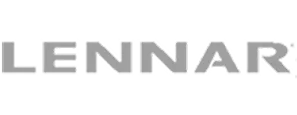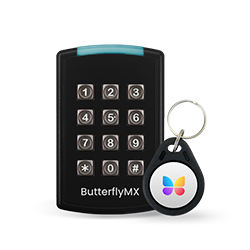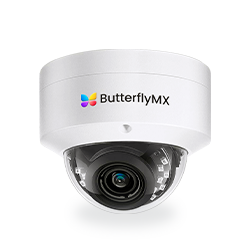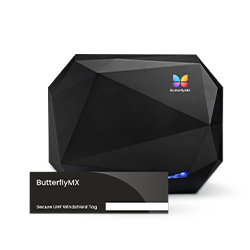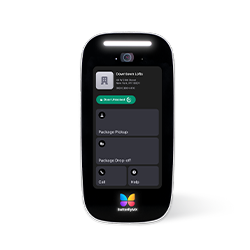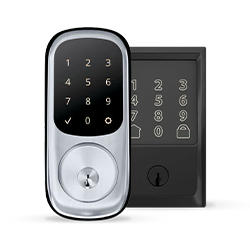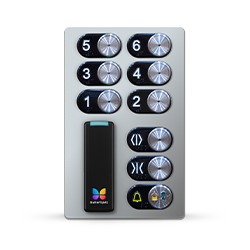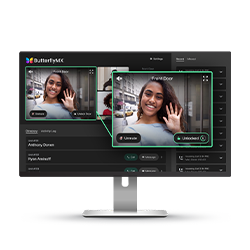Key takeaways
- An on-premises access control system is hosted locally, while a cloud-based access control system is hosted remotely and managed via the internet.
- Both cloud and on-premises systems for gated communities can offer strong protection when implemented correctly.
- There’s no one-size-fits-all answer when it comes to cloud vs on-premises access control for gated communities, but for most modern buildings, cloud-based systems offer greater flexibility, lower maintenance, and easier scalability.
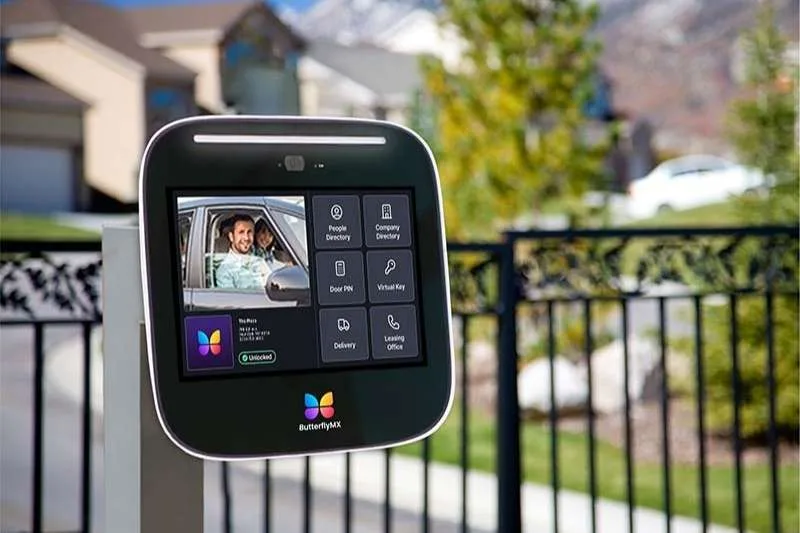
As building security becomes smarter and more connected, choosing the right access control system has never been more important. One of the biggest decisions property managers and owners face is whether to go with an on-premises or cloud-based access control system.
Cloud and on-prem systems each offer unique advantages, and what works best depends on your building’s needs, infrastructure, and long-term goals. In this post, we’ll break down the key differences between the two, explore the pros and cons of each approach, and help you decide which system makes the most sense for your property.
Navigate this post:
- What is the difference between cloud and on-premises access control for gated communities?
- Pros and cons of cloud-based access control for gated communities
- Pros and cons of on-premises access control for gated communities
- Cloud vs on-prem: Which is more secure?
- Cloud vs on-prem: Which is more cost-effective?
- When to choose cloud-based access control
- When to choose on-premises access control
- Which access control system is best?
- Cloud vs. on-premises access control for gated communities FAQs
More than 40K, 5-star reviews!

Video Intercoms
Open doors, gates & garages from anywhere.

QR Code Intercom
Smartphone-based visitor access.
Access Control
Fob, key cards, PINs, and mobile apps.
Security Cameras
Visibility throughout your property.
Vehicle Access
Hands-free access for gates & garages.
Package Room
Receive, store, and manage deliveries.
Smart Locks
Connect to all major brands and models.
Elevator Controls
Unlock key-fobbed elevators for anyone.
Front Desk Station
See all your doors and cameras in one place.
What is the difference between cloud and on-premises access control for gated communities?
The main difference between cloud-based and on-premises access control lies in where the system’s data and software are hosted and how they’re managed.
An on-premises access control system is hosted locally. That means the software, servers, and databases live on-site, typically in a dedicated IT room or server closet. Property staff or a third-party IT team is responsible for installing, updating, and maintaining the system.
By contrast, a cloud-based access control system is hosted remotely and managed via the internet. This model is often referred to as access control as a service (ACaaS), emphasizing cloud-hosted access control that eliminates the need for on-site servers. Instead of requiring on-site servers, the system’s data is stored in the cloud (often via trusted providers like AWS), and users manage access through a web or mobile dashboard. Updates are handled automatically by the provider, and system settings can be adjusted from anywhere.
Think of it like this: On-prem systems are like saving your files on a USB drive, while cloud systems are like using Google Drive, more flexible, easier to manage remotely, and always up to date.
Pros and cons of cloud-based access control for gated communities
Pros:
- Remote management. With a cloud-based system, property managers can monitor access, unlock doors, and adjust permissions from anywhere. Whether you’re on-site or across the country, you can stay in control.
- Easy updates and maintenance. One benefit of cloud-based access control is that providers handle software updates and security patches automatically, no need to schedule downtime or call IT. Your system is always up-to-date with the latest features and protections.
- Scalable across multiple properties. Managing a portfolio? Cloud-based access control makes it easy to centralize access management across multiple sites. You can oversee dozens (or even hundreds) of buildings from a single platform.
- Seamless integrations. Cloud systems often work with other smart building tools like video intercoms, property management software, and smart locks, creating a unified experience for residents and staff.
Cons:
- Requires an internet connection. If your internet goes down, certain features may be temporarily unavailable. However, many systems offer local failover options to keep doors secure during outages.
- Ongoing subscription fees. Cloud access control is typically billed on a monthly or annual basis. While this often results in a lower upfront cost, it does mean an ongoing operating expense.
- Security perceptions. Some operators may feel more comfortable hosting sensitive data on-site. But in reality, most cloud systems offer bank-level encryption and robust cybersecurity, often more secure than DIY server rooms.
Pros and cons of on-premises access control for gated communities
Pros:
- Full control over your system. With on-premises access control for gated communities, your IT team manages the entire system, from data storage to user access. This hands-on approach gives you complete control over how the system is configured, secured, and maintained.
- May support strict compliance requirements. Certain industries or government-regulated buildings may require on-prem storage due to privacy laws or internal security policies. On-prem systems make it easier to comply with these kinds of regulations.
- No ongoing subscription fees. Since on-prem systems are typically sold as one-time purchases, they don’t require recurring payments for software access. That can be appealing to teams looking for a capital expenditure rather than an operating expense.
Cons:
- High upfront and maintenance costs. Installing an on-premises system can be expensive. You’ll need to purchase servers, set up infrastructure, and invest in IT support. Maintenance, updates, and troubleshooting also fall entirely on your team.
- Limited remote capabilities. Unlike cloud-based systems, on-prem access control for gated communities usually can’t be managed off-site. If a resident is locked out or a security incident occurs after hours, your team may need to be on-site to respond.
- Difficult to scale. Adding new doors, buildings, or users to an on-prem system can be time-consuming and costly, especially if your system wasn’t designed with growth in mind.
- Manual updates and security patches. You’re responsible for keeping software up to date. That means scheduling regular updates and ensuring your system is protected against the latest vulnerabilities, which can quickly become a burden for smaller teams.
Cloud vs on-prem: Which is more secure?
Security is a top priority when choosing an access control system. Both cloud and on-premises systems for gated communities can offer strong protection when implemented correctly. But how they handle security differs significantly.
On-premises systems are often seen as more secure because all data is stored locally. You control who has access to your servers, how your network is configured, and when updates are applied.
However, this also means your team is solely responsible for maintaining physical security, installing patches, and guarding against cyber threats. If your server room isn’t properly secured or if software goes unpatched, your system could be vulnerable.
Cloud-based systems, on the other hand, store data off-site on highly secure servers hosted by cloud providers like AWS or Microsoft Azure. These providers invest heavily in cybersecurity, offering features like end-to-end encryption, redundant backups, and around-the-clock monitoring. Plus, most cloud access control vendors push security updates automatically, reducing the risk of human error.
So, is AWS more secure than on-prem? In many cases, yes. For most buildings, a well-designed cloud system with strong encryption and reliable vendor support is often more secure than a DIY on-prem setup.
Cloud vs on-prem: Which is more cost-effective?
Cost plays a big role in choosing an access control system and the long-term expenses of cloud vs on-prem for gated communities can vary widely.
On-premises access control usually comes with high upfront costs. You’ll need to purchase hardware, install servers, and potentially hire IT staff to manage the system. While there are fewer ongoing fees, the burden of maintenance, software updates, and troubleshooting often adds hidden costs over time, especially if your system grows more complex.
Cloud-based access control, by contrast, typically operates on a subscription model with lower upfront hardware costs. Instead of managing your own servers, you pay a monthly or annual fee for access to the platform. The ongoing cost may be higher over many years, but it includes updates, maintenance, and customer support, and it scales more easily across multiple buildings.
The bottom line: On-prem systems may appear more cost-effective at first, but cloud access control often saves money in the long run, especially for growing portfolios or teams with limited IT resources.
When to choose cloud-based access control
Cloud-based access control is a smart choice for modern properties that value flexibility, scalability, and ease of use.
You should consider a cloud system if:
- You manage multiple buildings. Centralized management across locations is far simpler with cloud software.
- Your team needs remote access. Manage doors, users, and settings from anywhere without being tied to a server room.
- You want automatic updates. Let your provider handle security patches and feature rollouts behind the scenes.
- You’re planning to integrate with other proptech tools. Most cloud systems integrate seamlessly with intercoms, smart locks, and property management platforms.
- You’re focused on long-term efficiency. While it may come with ongoing fees, cloud access control reduces IT burden and simplifies scaling.
When to choose on-premises access control
On-prem systems still serve an important role in certain scenarios, particularly when customization, compliance, or full data control is non-negotiable.
You might prefer an on-prem setup if:
- You’re subject to strict data regulations. Some government or high-security facilities may require on-site data storage.
- You already have robust IT infrastructure. If your property has a secure server environment and a dedicated IT team, managing an on-prem system may be feasible.
- You prefer to avoid ongoing subscription fees. On-prem solutions are typically paid for up front and don’t require monthly payments (though maintenance costs still apply).
- You want full control over every aspect of your system. From updates to user permissions, your team decides how and when changes are made.
Which access control system is best?
When it comes to cloud vs on-premises access control for gated communities, there’s no one-size-fits-all answer, but for most modern buildings, cloud-based systems offer greater flexibility, lower maintenance, and easier scalability.
Cloud access control allows property managers to remotely manage multiple buildings, reduce IT overhead, and stay ahead with automatic updates and integrations. That’s why it’s quickly becoming the standard for multifamily and commercial properties alike.
However, if your building has strict data compliance needs, existing IT infrastructure, or you simply prefer full control over every aspect of the system, an on-premises setup could still make sense.
Cloud vs. on-premises access control for gated communities FAQs
What is the difference between cloud and on-premise access control?
Cloud-based access control systems are hosted remotely and accessed via the internet, while on-premise systems are hosted locally on-site using in-house servers and infrastructure. Cloud systems offer remote management and scalability, whereas on-prem systems offer localized control and may be preferred for certain compliance needs.
What is the difference between cloud security and on-premises security?
Cloud security relies on encryption, secure data centers, and automatic updates managed by the provider. On-premises security, on the other hand, is controlled by your internal team and depends on your physical and digital protections. Both can be secure, it depends on the implementation.
What are the pros and cons of cloud-based access control?
Cloud systems offer remote access, easy updates, and better scalability, but they require a stable internet connection and come with ongoing subscription fees. For most properties, the benefits far outweigh the drawbacks.

Get your free quote!
Fill in the form below, and we'll email you right back.
Want a free quote?
Fill in the form below, and we'll email you right back.
You’ll be redirected shortly...
